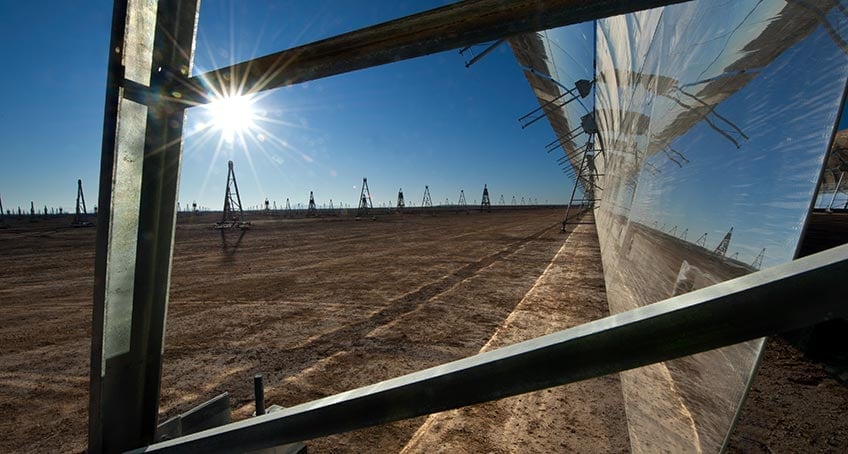Concentrating Solar Power Basics
Concentrating solar power systems harness heat from sunlight to provide electricity for large power stations.

Light is reflected in a parabolic trough collector at Abengoa's Solana Plant, serving over 70,000 Arizona homes. Photo by Dennis Schroeder / NREL
Many power plants today use fossil fuels as a heat source to boil water. The steam from the boiling water spins a large turbine, which drives a generator to produce electricity. However, a new generation of power plants use concentrating solar power systems and the sun as a heat source. The three main types of concentrating solar power systems are: linear concentrator, dish/engine, and power tower systems.
Linear Concentrator Systems
Linear concentrator systems collect the sun's energy using long rectangular, curved (U-shaped) mirrors. The mirrors are tilted toward the sun, focusing sunlight on tubes (or receivers) that run the length of the mirrors. The reflected sunlight heats a fluid flowing through the tubes. The hot fluid then is used to boil water in a conventional steam-turbine generator to produce electricity.
There are two major types of linear concentrator systems: parabolic trough systems, where receiver tubes are positioned along the focal line of each parabolic mirror; and linear Fresnel reflector systems, where one receiver tube is positioned above several mirrors to allow the mirrors greater mobility in tracking the sun.
Dish/Engine Systems
A dish/engine system uses a mirrored dish similar to a very large satellite dish, although to minimize costs, the mirrored dish is usually composed of many smaller flat mirrors formed into a dish shape. The dish-shaped surface directs and concentrates sunlight onto a thermal receiver, which absorbs and collects the heat and transfers it to the engine generator.
The most common type of heat engine used today in dish/engine systems is the Stirling engine. This system uses the fluid heated by the receiver to move pistons and create mechanical power. The mechanical power is then used to run a generator or alternator to produce electricity.
Power Tower Systems
A power tower system uses a large field of flat, sun-tracking mirrors known as heliostats to focus and concentrate sunlight onto a receiver on the top of a tower. A heat-transfer fluid heated in the receiver is used to generate steam, which, in turn, is used in a conventional turbine generator to produce electricity.
Some power towers use water/steam as the heat-transfer fluid. Other advanced designs are experimenting with molten nitrate salt because of its superior heat-transfer and energy-storage capabilities. The energy-storage capability, or thermal storage, allows the system to continue to dispatch electricity during cloudy weather or at night.
Additional Resources
For more information about concentrating solar energy, visit the following resources:
Concentrating Solar Power Research at NREL
Concentrating Solar Power
U.S. Department of Energy's Office of Energy Efficiency and Renewable Energy
Share
Last Updated March 25, 2025
